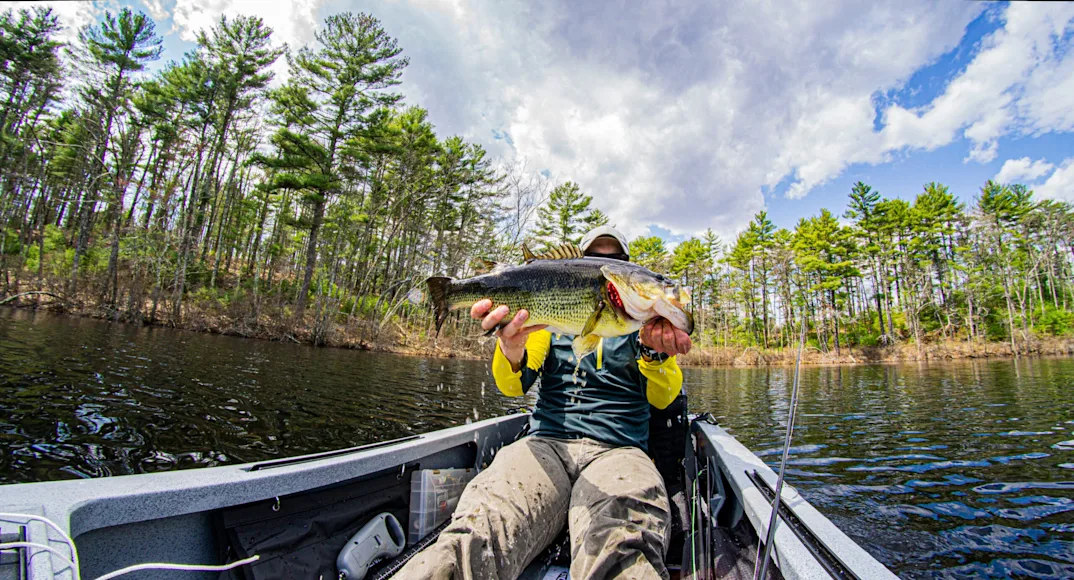_We may earn revenue from the products available on this page and participate in affiliate programs. Learn more ›
_
Best Topwater
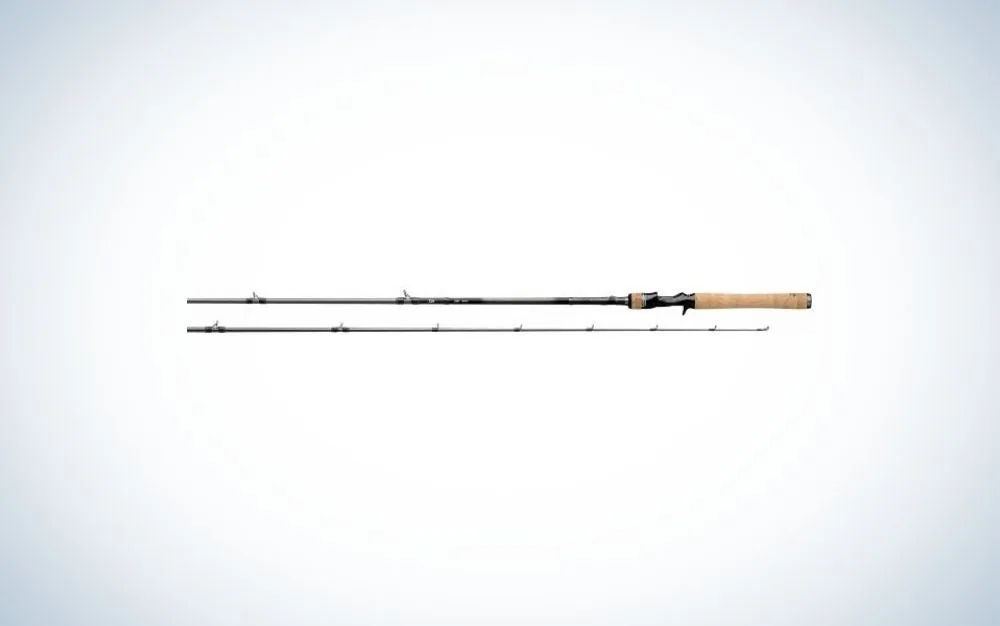
Daiwa Tatula
LEARN MORE
Summary
Crisp feel and length will improve your topwater fishing, be it popping, twitching or walking the dog.
Best Overall
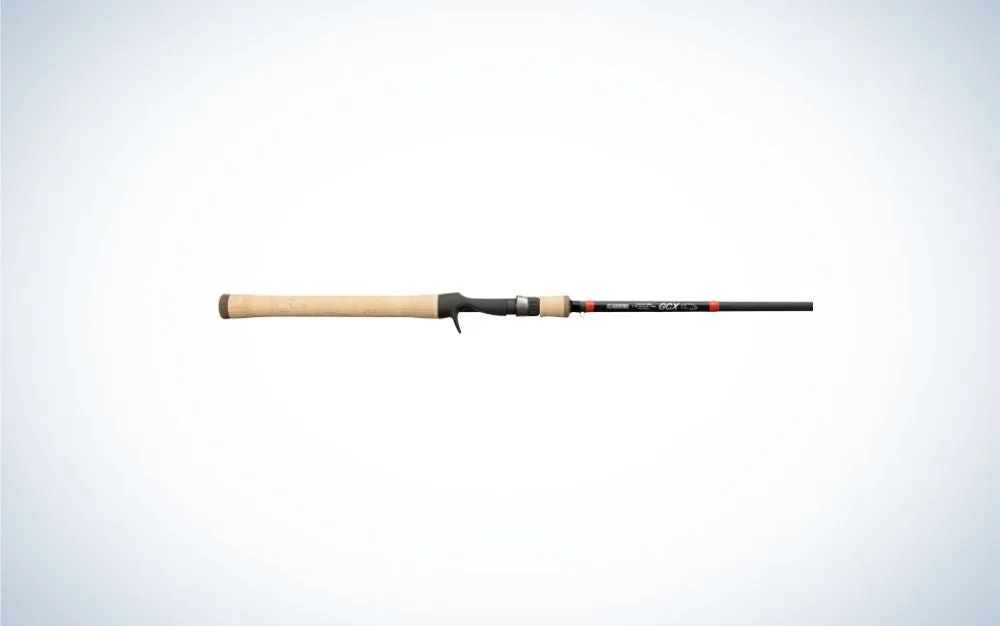
G. Loomis GCX, 843c MBR
LEARN MORE
Summary
This rod uses the same engineering as the company’s higher-end offerings—a great rod at this price.
Best Budget
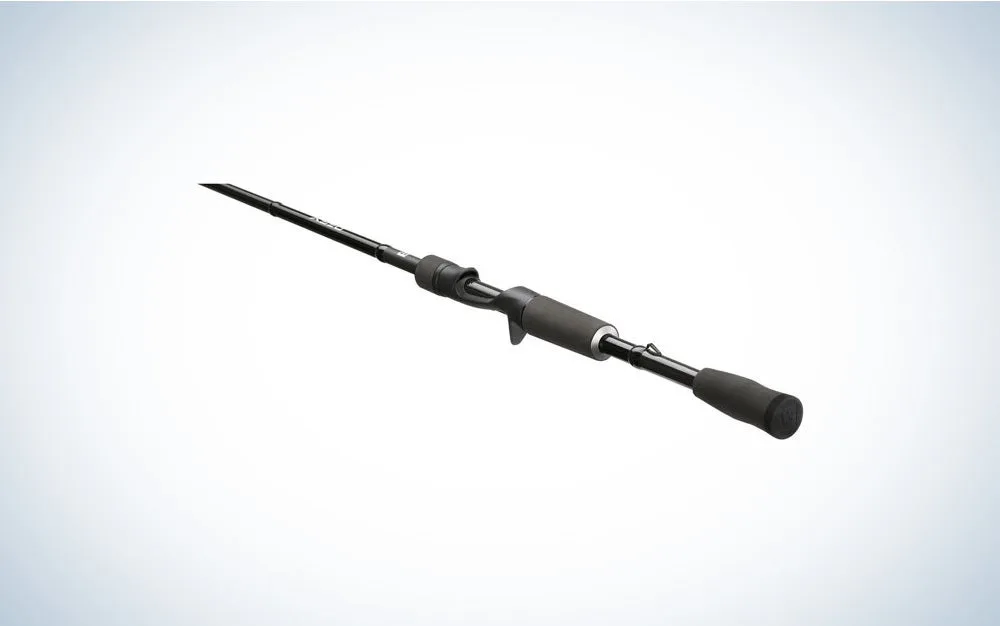
13 Fishing Defy Black
LEARN MORE
Summary
The same performance and versatility that you’d expect from more expensive models.
The best baitcasting rods for bass make fishing feel effortless. They’re lightweight, fishing all day in comfort. They’re sensitive, transmitting the slightest bite or subtlest lure wiggle directly to your fingers. And they cast with ease, putting lures on target.
Baitcasting rods are for heavy lifting, literally and figuratively. They handle thick lines, cast weighty lures and extract bigger bass from nastier cover better than spinning rods. They also make precise presentations, such as flipping and pitching, possible. That’s why more times than not, you’ll find a bass angler holding one.
Picking up the best one starts well before you get on the water. It’s rooted in design, materials, components and other characteristics. Assemble the best of each, and you’ll have the best baitcasting rods for bass.
Best Overall: G. Loomis GCX, 843c MBR
Best Rod-and-Reel Combo: Bass Pro Shops Johnny Morris CarbonLite 2.0
Best Topwater: Daiwa Tatula, TTU701
Best Budget: 13 Fishing Defy Black, DB2C71MH
Things to Consider Before Buying a Baitcasting Rod for Bass
At first glance, baitcasting rods are simple tools — handle, blank and line guides. But that belies the forethought, design and engineering that goes into even the least expensive ones. The goal of that effort is to create balance and function from the rod’s tip to its butt. But success varies among baitcasting rods. Consider these attributes, and you’ll find the best fishing rods for catching bass
.
Action and power
Bar none, action and power say more about a baitcasting rod than any other attribute. While they work independently and can be found in any combination, they dictate a baitcasting rod’s capabilities, including casting lures, feeling bites and stopping a big bass from wrapping your line around a dock post.
Action describes how a rod bends through its length. It’s best seen by placing the rod’s tip on the floor then rolling your wrist to load the blank. It’s available in these three degrees. Search out combinations—i.e. extra fast—to better match your on-the-water needs.
Fast: Only the tip bends, creating a crisp feel that increases casting accuracy and adds power to hooksets. Use it to fish Texas-rigged soft-plastics and other lures that sport a single hook.
Moderate: Bend is from tip through midsection. It’s the most versatile action, allowing a rod to handle a wide range of lures and techniques.
Slow: Bend is from tip to handle. While rods with this action create plenty of casting distance, their accuracy is poor. All that flex also acts like a shock absorber, helping keep surging bass hooked.
Power is the amount of force that a rod can handle. Lure and line weights and how hard you can pull against a hooked bass are rooted in this characteristic. As with action, a rod can have a combination of powers such as medium-heavy or ultralight.
Heavy: The most powerful, it’s found in flipping, swimbait and spinnerbait rods. It can handle the heaviest lures and strongest lines.
Medium: Middle-of-the road, it’s found in all-purpose rods, which do a good job with a variety of lures and techniques.
Light: The least powerful, it’s found in rods used to cast small swimbaits, small crankbaits and finesse jigs. Take your time, and it’ll whip the biggest bass.
Rods from different manufacturers, even those from different series from the same builder, can feel different even if they’re labeled with the same action. Less-expensive rods, for example, often feel slower than more expensive ones labeled with the same action. Keep that in mind when you’re trying to fine-tune a rod’s action to your needs.
Handle and grip
A baitcasting rod can pack a lot of performance. But if it doesn’t feel right in your hand, then you’re not going to use it. Finding the best combination of handle and grip is important.
Cork handle: Natural material that’s lightweight and easy to clean. It transmits vibrations well and provides a firm grip, even when wet or slathered with fish slime.
Foam handle: Synthetic material that provides all-day comfort. Water or fish slime can make it slippery. It’s less sensitive than cork.
Grip handle: The latest offering, it feels like rubber and offers plenty of traction in all conditions. More comfortable to use when compared to cork and foam because you don’t have to hold it as tightly to maintain the same amount of control.
Full grip: Handle continues uninterrupted from reel seat to the rod’s butt. Designed for two-handed casts, it’s the best choice for long rods and heavy lures.
Split grip: A portion of the rod’s blank is exposed between the reel seat and butt. A popular look with many anglers, it cuts a rod’s overall weight.
Length
Casting distance and lure presentation are directly related to a rod’s length. While some bass anglers go to the extreme with 10-footers, you’ll find the most versatility and ease of use in ones that measure between 6-feet, 6-inches and 8-feet. What, where and how you plan to fish determines where on that range a rod falls.
6- to 7-feet long: Best for short to medium distance presentations in water 20 feet or shallower. This length is extremely versatile, creating an all-around rod that’s easy for anglers of all heights to operate.
7- to 7-feet, 6 inches long: Best for specialized techniques, such as launching crankbaits to offshore spots with long overhand casts and precisely placing jigs on shallow-water targets with underhand flips.
7 1/2- to 8-feet long: Best in extreme situations such as super long casts and flipping the thickest cover. The extra length provides leverage that shorter rods can’t match. They can feel unwieldy to inexperienced or short anglers.
Components
Blanks and handles go a long way toward determining a rod’s performance. But other parts play roles, too. Exposed reel seats allow you to place a couple fingers directly on the rod’s blank, giving you a better feel of what’s happening with your lure. Single-foot line guides increase sensitivity, too, by reducing the number of attachment wraps around the blank. Other features, such as a hook retainer and line-size indicator, don’t directly improve a rod’s performance, but you’ll appreciate having them.
Warranty
No one intends to break a fishing rod, especially ones that you consider your best. But accidents happen, even if that’s what you want to call your fishing partner shutting it in a car door or rod locker lid. So, it pays to know what the manufacturer offers in the way of a warranty or replacement program. The longer the coverage and fewer the stipulations, the better.
Best Overall: G. Loomis GCX, 843c MBR
Best Overall

G. Loomis GCX, 843c MBR Walmart
This Washington state-built rod uses the same engineering as the company’s high-end offerings. That’ll help you catch more and bigger bass in a variety of situations.
Key features
Action and Power: Fast action, medium-heavy power
Handle and Grip: Cork handle, full grip
Length: 7 feet
Lure and Line Ranges: 1/4 to 3/4 ounce, 10- to 17-pound test
Warranty: Limited lifetime warranty
Pros:
High-performance construction
Extremely sensitive
Designed for specific fishing situations
Cons:
Weighs more than similar rods in other series
Released in 2021, G. Loomis’ GCX
series includes more than 20 models that let you cash in on the legendary company’s industry leading technology, craftsmanship and quality without breaking your bank. This rod is a multitasker, able to deftly handle finesse jigs for spotted bass and rip big double-willow spinnerbaits for smallmouth who woke up on the wrong side of the bed.
This 7-foot medium-heavy power rod’s abilities are rooted in its blank’s multitaper design. It allows engineers to perfectly place graphite, accentuating durability and sensitivity while fine-tuning action and power. You’ll appreciate that when you lean into the rod’s backbone on a hook set and use the tip to complete a perfect underhand roll cast, over and over again. Lightweight SeaGuide Hero One guides reduce tangles and increase casting distance.
G. Loomis considers GCX its entry-level series. So, while the rod’s weight may be comparable to similar ones made by other manufacturers, it won’t have that feather-like feel of the company’s IMX-PRO, NRX+ and other more-expensive series.
Best Rod-and-Reel Combo: Bass Pro Shops Johnny Morris CarbonLite 2.0
Best Rod-and-Reel Combo
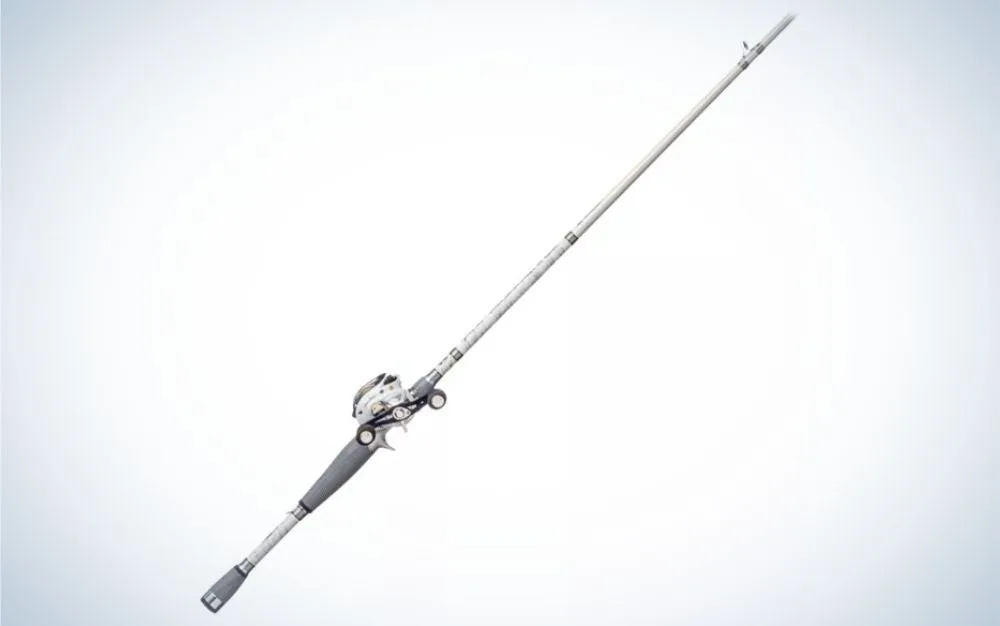
Bass Pro Shops Johnny Morris CarbonLite 2.0 Bass Pro Shop
Wearing the best-known badge in the bass-fishing business, this combo is balanced and battle ready. All you need is line and a ride to the lake.
Key features
Action and Power: Fast action, medium-heavy power
Handle and Grip: Winn grip handle with split grip
Length: 7 feet
Lure and Line Ranges: 3/8 to 1 ounce, 10- to 20-pound test
Warranty: 10 years on rod, one year on reel
Pros:
Versatile action-power combination
Comfortable Winn grip reduces fatigue
Equipped with a matching reel
Cons:
Action feels faster than label
Preselected reel-and-rod combinations
Finding a reel that perfectly matches a baitcasting rod can be tricky business, whether you’re a newbie looking for your first setup or experienced angler expanding into new techniques. Bass Pro Shops removes all of that guesswork with its Johnny Morris CarbonLite 2.0
baitcasting rod-and-reel combos.
While this baitcasting rod also is offered in a two-piece version, this particular combo takes advantage of the extra strength and sensitivity that’s inherent to a one-piece. Those attributes are a result of Carbon Coil Technology, which reinforces RT4 graphite by shaping it into a double helix.
This CarbonLite2.0 rod produces long and accurate casts. Line moves smoothly and freely through its lightweight Fuji FazLite guides. Its split grip is covered with a tacky Winn handle, so you won’t have to hold on as tightly, decreasing hand cramps and fatigue. That helps you fish longer and cast farther and more accurately. It also features a lightweight reel seat that exposes a large section of blank. A line ID dial in the rod’s butt makes it easy to keep track of rigging and ensure you grab the rod you want.
The other half of this combo is a Johnny Morris CarbonLite 2.0 reel. It’s well-equipped, featuring a one-piece aluminum frame, 10 bearings and a machined aluminum V-spool that holds 120 yards of 12-pound test monofilament or fluorocarbon or 150 yards of 30-pound test braid. It features an 8.3:1 gear ratio that gobbles up 34 inches of line with each handle turn.
As is the case with other mass-produced rods, this one’s action may feel faster than its label. The lack of flex will rear its head while casting, reducing consistency and distance, and keeping bass hooked on trebles, whose multiple points dissipate any pressure that you apply. While these rods and reels are well matched, you have to take what you get to enjoy the combo price, which is less than purchasing each separately. You’re out of luck if you’re searching for something personalized to your fishing.
Best Topwater: Daiwa Tatula, TTU701MRB
Best Topwater

Daiwa Tatula, TTU701MRB Tackledirect
This rod’s crisp feel and length will improve your topwater fishing, whether you’re popping, twitching or walking the dog.
Key features
Action and Power: Moderate-fast action, medium power
Handle and Grip: Cork handle with full grip
Length: 7 feet, 1 inch
Lure and Line Ranges: ¼ to ¾ ounce, 10- to 17-pound test
Warranty: Five-year limited warranty
Pros:
Length casts lures further
Handles wide range of lure weights
Action makes working topwater lures easy
Cons:
Lacks power needed to fish heavy cover and single-hook topwaters
Micro guides eliminates use of leaders
Most topwaters catch best in clear water, where bass easily see their subtle movements. But that advantage also is a disadvantage because it makes bass wary, too. Overcome it with this Tatula rod
, whose length, action and power combine to launch topwaters, from small poppers whose weight is equivalent to a foam cup to large walking baits such as a Zara Spook, further from your boat, where bass are relaxed and ready to bite.
Part of a series that includes more than 20 technique-specific spinning and baitcasting models, this rod is loaded with performance enhancing features, thanks to careful engineering and construction. At its heart is Daiwa’s Braiding-X Fiber Technology. It creates the rod’s X-45 blank, which feels light and won’t twist or “ovalize” under load. That strength, along with tangle-free Fuji FazLite line guides, generate longer and more accurate casts.
Be mindful of this rod’s medium power. You won’t be able to horse hooked bass from heavy cover or set single-hook lures, such as buzzbaits and soft-plastic toads, with any authority. And its small diameter line guides detest knots, making casting braid-to-leader setups difficult. You’ll be better off stringing it with straight braid or monofilament, which unlike fluorocarbon, floats.
Best Budget: 13 Fishing Defy Black, DB2C71MH
Best Budget

13 Fishing Defy Black, DB2C71MH
A bargain that keeps cash—not coins—in your pocket, this rod offers a level of performance and versatility typically found on more expensive models.
Key features
Action and Power: Fast action, medium heavy
Handle and Grip: Split grip with EVA foam handle
Length: 7 feet, 1 inch
Lure and Line Ranges: 3/8 to 1 ounce, 12- to 20-pound test
Warranty: 1-year limited warranty
Pros:
Uses technology found on more expensive rods
Action and power offer plenty of versatility
EVA foam grip brings all-day comfort
Cons:
Action feels faster than its label
Hook keeper is located on handle
Lightweight and sensitive, this 13 Fishing Defy Black casting rod
’s performance is priceless. You’ll feel its crisp action in its tip, adding casting accuracy and making it easier to work bottom-bouncing lures such as Texas-rigged soft plastics. Further down the blank, there’s plenty of backbone, ready to hook bass swimming on your deepest spots.
13 Fishing, which manufacturers reels and lures, too, turned to its high-end rods for inspiration, including the taper used in the blank, which is constructed of durable 24-ton graphite. It’s built with a seamless reel seat and stainless steel line guides outfitted with polished Alconite inserts, which add casting distance by reducing friction. Its spit grip has an EVA foam handle, reducing the rod’s overall weight and increasing comfort.
But a dollar only stretches so far. If you’re an experienced angler or have a quiver of casting rods, this one may feel stiffer than other rods labeled fast action. That will make casting lures at the lighter end of its range slightly more difficult and put more pressure on treble hooks while battling bass, giving them a better chance of freeing themselves. Use caution when attaching lures to its hook keeper, which is on the grip’s split. Tangles are more likely, as is sticking yourself, when rummaging through a full rod locker. Hook the lure on the reel instead.
How I Made My Picks
An educated hand can quickly uncover a baitcasting rod’s quality. But getting to that point takes time. I’ve invested plenty over the past 30 years, chasing the three most-popular species of bass in rivers, reservoirs and lakes up and down the East Coast. Whether a lazy afternoon during a family vacation or the heat of battle during a regional bass tournament, those experiences helped me learn what a baitcasting rod needs, and what it doesn’t, to be among the best.
As with our other expert reviews that help you find the best baitcasting rods
, several questions need to be asked:
How does it perform? All rods can cast lures and land bass. But the best ones create accuracy, distance and power. Having all three will make you a better angler through increased efficiency. If you need to cast a crankbait farther so it runs deeper, reaching the lip of a creek channel swarming with summertime largemouth, the best baitcasting rods will get that done.
How versatile is it? While you can find a baitcasting rod that does one thing extremely well, it’s better if it can do several things really well. That prepares you for more fishing situations, whether flinging topwaters to smallmouth crushing yellow perch on top of a shallow shoal or slow rolling a spinnerbait down a laydown in a backwater warmed by springtime sunshine.
What components does it use? The reel seat, handle and line guides turn a blank into a functioning rod. They need to perform in a host of conditions and add to a rod’s performance, whether that’s casting distance, detecting bites or boat flipping 6-pounders.
The baitcasting rods on this list have unique answers to these questions. Each can be used in more than one on-the-water situation, perform consistently and incorporate components whose function clearly out-distances their form.
FAQs
Q: What is a medium baitcasting rod good for?
A medium baitcasting rod is good for fishing midsized lures through spots with sparse cover such as a rocky flat with scattered clumps of aquatic vegetation or riprap bank. Medium describes the rod’s power, which is the amount of lure and line weight that the rod can effectively handle. Use too light of line or too heavy of a lure, for example, and the rod or line could fail. The typical medium baitcasting rod handles 8- to 15-pound test line and lures such as crankbaits that dive to about 10 feet deep, lightweight walking and popping topwaters, small Texas rigged soft plastic lures, and spinnerbaits weighing ¼ or ⅜ ounce.
Q: What is the most sensitive baitcasting rod?
The most sensitive baitcasting rods have two important traits. They only flex at the tip. This extra-fast action loads quickly, immediately transferring vibrations—bass bites or lure movements—to your hand. Along with that, they are made from graphite. It creates the crisp action and helps transmit vibrations down its length. Certain components can improve the sensitivity of any baitcasting rod. Single-foot line guides contact the blank once, reducing any deadening along the blank, and handles made from dense cork amplify vibrations. Search out reel seats that expose the blank. That allows you to place a finger or two directly on the blank.
Q: What is the best rod for baitcasting long distance?
The best rod for baitcasting long distance measures 7 feet, 6 inches long. While one 8 feet or longer may give you more distance, casting them often is often difficult for the average angler. It needs a long handle that you can comfortably grab with two hands to gain leverage. Its action—how the rod bends under load—should be moderate. It should have a medium-heavy or heavy power, which will cast heavier lures and achieve greater distance. And spool its reel with braided line. You don’t necessarily want it for its strength. You want it for its small size—15-pound test braid, for example, is about the same diameter of 4-pound test monofilament line. That will add casting distance, too.
Q: What is the best length for a baitcasting rod?
The best length for a baitcasting rod is 7 feet. That’s long enough to create reasonable casting distance when fishing offshore spots such as channel ledges and points. It also can handle pitching and flipping, the underhand swinging casts that create precise presentations closer to the boat. But it’s not too long to hamper techniques that require your rod’s tip to be pointed at the water such as getting a bit more depth from a crankbait or twitching a jerkbait. Unlike shorter and longer rods, 7-footers come in a wider variety of actions, powers, and line and lure weight ranges, making it easy to match your gear to a specific technique or fishing situation. And they’re easy to store in the rod locker of nearly all boats, smaller vehicles and rooms with 8-foot ceilings—though keep them away from ceiling fans.
Final Thoughts
Don’t settle for a good baitcasting rod when you can have the best. Those offer the right mix of attributes, from how they feel in your hand to how they handle the big bass that you just hooked. Using them will make you a better bass angler.

